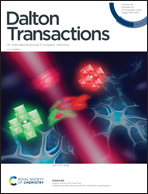Studies on the influence of the nuclearity of zinc(ii) hemi-salen complexes on some pivotal biological applications†
Abstract
Though a large amount of literature has been reported on outlining the biological significance of zinc(II) Schiff base complexes, yet none of them have explored the influence of nuclearity on their properties. This report elaborates the targeted syntheses of two different hemi-salen ligands for their ability to produce Zn(II)-complexes with different nuclearity. Herein, one dimeric, [Zn2L12(N3)2] (1) and one trimeric [Zn3L22(N3)4] (2) [HL1 = (2-(((2-(diethylamino)ethyl)imino)methyl)phenol, HL2 = 2-(((3-(dimethylamino)-2,2-dimethylpropyl)imino)methyl)-6-methoxyphenol] complexes of hemi-salen ligands have been thoroughly screened for various biological studies including cytotoxic assay, DNA/protein-complex interplay, fluorescence imaging, and antibacterial pathogen tests. The trimer features the IC50 value of 9.651 ± 0.026 μM against the HeLa cancer cell line, one of the best figure by any Zn(II) hemi-salen complex to date. How the nuclearity dependency affects the supramolecular interactions is also a key point of interest in this study. The compounds exhibit strong DNA binding affinity and the dimer 1 predominantly binds to the minor grooves of DNA (binding energy = −5.8 kcal mol−1), whereas trimer 2 prefers the intercalative mode (binding energy = −7.1 kcal mol−1) in contrast to groove binding (binding energy = −6.2 kcal mol−1). The atypical phenomenon behind the conformational changes of biomolecules by these zinc complexes has been investigated through experimental procedures and further corroborated theoretically. Apart from this, it has been found that even at very low concentration (≤10 μM) of the ligand, HL1 and complexes can be effective for live cell imaging. It is worth mentioning that HL1 could be useful for the specific staining of the cell cytoplasm. Furthermore, the complexes have shown promising anti-bacterial activity; thus, they can be convenient for multiple biological applications.



 Please wait while we load your content...
Please wait while we load your content...